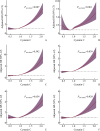Cystatin C is associated with osteoporosis and fractures: An observational study based on Mendelian randomization analysis
- PMID: 40074311
- PMCID: PMC11897978
- DOI: 10.11817/j.issn.1672-7347.2024.240147
Cystatin C is associated with osteoporosis and fractures: An observational study based on Mendelian randomization analysis
Abstract
Objectives: Osteoporosis is characterized by decreased bone mass and damaged bone microstructure, often leading to fragility fractures. Low bone mineral density is a key risk factor for fractures. Serum cystatin C (CysC), an endogenous marker of glomerular filtration rate, is negatively correlated with bone mineral density and may be a potential risk factor for osteoporosis. This study aims to investigate the association and potential pathogenic mechanisms between CysC and osteoporosis and fractures in the general population by combining cohort analysis and Mendelian randomization (MR) analysis.
Methods: Large-scale prospective cohort data from the UK Biobank and summary statistics from genome-wide association study (GWAS) in European populations were utilized, with strict exclusion criteria applied (excluding non-white individuals, those with thyroid diseases, gastrointestinal dysfunction, kidney diseases, rheumatoid diseases, malignant tumors, chronic infections or inflammatory diseases, diabetes, hypertension, and individuals taking medications that affect bone metabolism). Multivariable linear regression, logistic regression, and Cox proportional hazards models were used to analyze the relationship between CysC and bone mineral density, osteoporosis, and fracture risk. All analyses were performed using three sequential models to adjust for confounding factors: Model 1 adjusted for demographic characteristics and lifestyle factors; Model 2 further adjusted for renal function based on Model 1; and Model 3 further adjusted for physical activity based on Model 2. Restricted cubic spline models were used to explore non-linear relationships, and MR analysis was conducted to assess the causal associations between CysC and osteoporosis and fractures.
Results: Multivariate analysis showed that after adjusting for basic variables (Model 1), there was no correlation between CysC and estimated bone mineral density (eBMD) in the overall study population; however, when stratified by gender, both males and females exhibited a significant negative correlation (P<0.001). After further adjustment for renal function (Model 2) and physical activity level (Model 3), CysC became negatively correlated with eBMD in the overall population (P<0.001). Moreover, multivariable logistic regression consistently demonstrated that CysC concentration was significantly positively associated with osteoporosis risk (P<0.01), and this association remained stable across all models. In all populations and models, multivariate Cox regression analysis indicated that subjects in the highest quartile (Q4) of CysC had a significantly increased risk of developing osteoporosis (P<0.001). In the overall population, the positive association between Q4 CysC levels and fractures was observed only in Models 2 and 3, with a hazard ratio of 1.118 (both P<0.001); however, after gender stratification, this association disappeared in males (P>0.05). Additionally, restricted cubic spline regression analyses revealed a significant non-linear relationship between CysC and the incidence of osteoporosis and fractures (P<0.05). MR analysis, using 167 single nucleotide polymorphisms (SNPs) as instrumental variables, showed no direct causal relationship between CysC and osteoporosis or fractures (P≥0.05), a finding that differs from previous studies in special populations.
Conclusions: Elevated levels of CysC are significantly associated with an increased risk of osteoporosis and fractures, and this association is more pronounced in females. Renal function and physical activity levels may be important factors influencing this relationship. The link between CysC and osteoporosis and fractures may be mediated by several mechanisms: Eelevated CysC may lead to abnormalities in vitamin D and mineral metabolism, thereby inhibiting bone formation; renal dysfunction may exacerbate inflammation, affecting bone resorption; or in the osteoporosis state, increased osteoclast differentiation may result in elevated CysC levels. These findings support the potential use of CysC as a biomarker for predicting the risk of osteoporosis.
目的: 骨质疏松症以骨量减低和骨组织微结构损坏为特征,常引发脆性骨折。骨密度低是导致骨折的关键危险因素。血清半胱氨酸蛋白酶抑制剂C(cystatin C,CysC)是肾小球滤过率的内源性标志物,与骨密度呈负相关,可能是骨质疏松症的潜在危险因素。本研究旨在通过队列分析和孟德尔随机化(Mendelian randomization,MR)分析相结合的方法,探究CysC与骨质疏松症和骨折在普通人群中的关联和潜在的致病机制。方法: 利用英国生物银行的大规模前瞻性队列数据和欧洲人群的全基因组关联分析(genome-wide association study,GWAS)汇总统计数据(严格设置排除标准:非白人种族、甲状腺疾病、胃肠功能障碍、肾脏疾病、类风湿性疾病、恶性肿瘤、慢性感染或炎症性疾病、糖尿病和高血压等特殊疾病人群,以及正在服用影响骨代谢药物者)。采用多变量线性回归、Logistic回归和Cox比例风险模型分析CysC与骨密度、骨质疏松症和骨折发生风险的关系。所有分析均采用3个递进模型调整混杂因素:3种不同模型进行分析:模型1调整人口学特征和生活方式因素,模型2在模型1基础上进一步调整肾功能,模型3在模型2基础上调整体力活动水平。通过限制性立方样条模型探究其非线性关系,并使用MR分析评估CysC与骨质疏松症及骨折之间的因果关联。结果: 多变量分析显示,在调整基本变量后(模型1),总研究参与者中CysC与估计骨密度(estimated bone mineral density,eBMD)不存在相关性,但是在经过性别分层的男性和女性中均呈显著负相关(均P<0.001)。在调整肾功能(模型2)和体力活动水平(模型3)后,总研究参与者中CysC与eBMD开始呈负相关(P<0.001)。此外,多变量Logistic回归均显示CysC浓度与骨质疏松风险呈显著正相关(P<0.01),这种关联在所有分析模型中均保持稳定。在所有人群和模型中,多变量Cox回归分析结果均显示Q4组的CysC与骨质疏松症发生风险均呈正相关(均P<0.001)。在总人群中,Q4组的CysC与骨折之间的正向关联仅在模型2和模型3中出现,风险比均为1.118(均P<0.001)。然而经过性别分层后,这种关联在男性中消失(P>0.05)。此外,限制性立方样条回归分析结果显示CysC与骨质疏松症和骨折的发病存在非线性关系(P<0.05)。通过筛选167个单核苷酸多态性(single nucleotide polymorphisms,SNPs)作为工具变量进行MR分析,结果显示CysC与骨质疏松症和骨折之间并不存在直接的因果关系(P≥0.05),这一发现与既往特殊人群研究结果存在差异。结论: CysC水平升高与骨质疏松症和骨折风险增加具有显著相关性,这种关联在女性中表现更为明显。肾功能和体力活动水平可能是影响这种关联的重要因素。CysC与骨质疏松和骨折之间的关联可能的机制包括CysC升高导致维生素D和矿物质代谢异常,抑制骨形成;肾功能损伤加重炎症水平,影响骨吸收;或在骨质疏松症状态下,破骨细胞分化增加导致CysC水平升高。这些发现支持将CysC作为预测潜在骨质疏松症的生物学指标的可能性。.
Keywords: cystatin C; mendelian randomization analysis; osteoporosis, fractures; prospective cohort study.
Conflict of interest statement
作者声称无任何利益冲突。
Figures


Similar articles
-
Muscle-origin creatinine-cystatin C ratio is an osteoporosis marker in individuals with normal renal function: evidence from observational and Mendelian randomization analysis.Front Endocrinol (Lausanne). 2024 May 21;15:1325320. doi: 10.3389/fendo.2024.1325320. eCollection 2024. Front Endocrinol (Lausanne). 2024. PMID: 38836225 Free PMC article.
-
Causal Associations of Anthropometric Measurements With Fracture Risk and Bone Mineral Density: A Mendelian Randomization Study.J Bone Miner Res. 2021 Jul;36(7):1281-1287. doi: 10.1002/jbmr.4296. Epub 2021 Apr 5. J Bone Miner Res. 2021. PMID: 33784428
-
Assessment of causal association between the socio-economic status and osteoporosis and fractures: a bidirectional Mendelian randomization study in European population.J Bone Miner Res. 2024 Aug 5;39(7):942-955. doi: 10.1093/jbmr/zjae060. J Bone Miner Res. 2024. PMID: 38624186
-
Associations of Smoking and Alcohol and Coffee Intake with Fracture and Bone Mineral Density: A Mendelian Randomization Study.Calcif Tissue Int. 2019 Dec;105(6):582-588. doi: 10.1007/s00223-019-00606-0. Epub 2019 Sep 4. Calcif Tissue Int. 2019. PMID: 31482193 Review.
-
Using Mendelian Randomization to Decipher Mechanisms of Bone Disease.Curr Osteoporos Rep. 2018 Oct;16(5):531-540. doi: 10.1007/s11914-018-0467-3. Curr Osteoporos Rep. 2018. PMID: 30203249 Free PMC article. Review.
References
Publication types
MeSH terms
Substances
LinkOut - more resources
Full Text Sources
Medical

